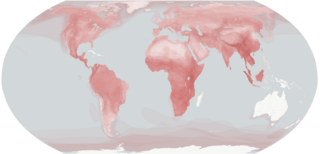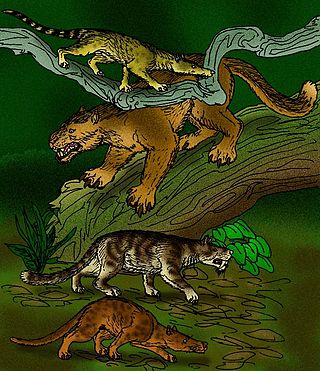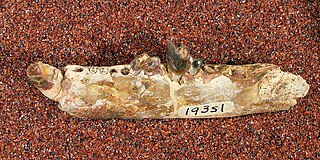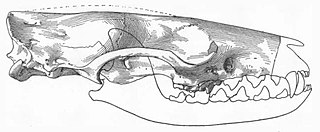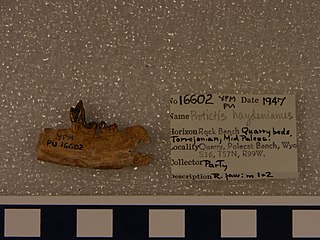- Genus: † Orientictis (Huang & Zheng, 2005)
- †Orientictis spanios(Huang & Zheng, 2005)
- Genus: † Pappictidops (Qiu & Li, 1977)
- †Pappictidops acies(Wang, 1978)
- †Pappictidops obtusus(Wang, 1978)
- †Pappictidops orientalis(Qiu & Li, 1977)
- Genus: † Preonictis (Tong & Wang, 2006)
- †Preonictis youngi(Tong & Wang, 2006)
- Genus: † Variviverra (Tong & Wang, 2006)
- †Variviverra vegetatus(Tong & Wang, 2006)
- Incertae sedis :
- Subfamily: † Didymictinae (Flynn & Galiano, 1982)
- Genus: † Bryanictis (MacIntyre, 1966)
- †Bryanictis microlestes(Simpson, 1935)
- †Bryanictis paulus(Meehan & Wilson, 2002)
- †Bryanictis terlinguae(Standhardt, 1986)
- Genus: † Didymictis (Cope, 1875)
- †Didymictis altidens(Cope, 1880)
- †Didymictis dellensis(Dorr, 1952)
- †Didymictis leptomylus(Cope, 1880)
- †Didymictis protenus(Cope, 1874)
- †Didymictis proteus(Polly, 1997)
- †Didymictis vancleveae(Robinson, 1966)
- †Didymictis sp. [Erquelinnes, Hainaut, Belgium] (Dollo, 1909)
- Genus: † Intyrictis (Gingerich & Winkler, 1985)
- †Intyrictis vanvaleni(MacIntyre, 1966)
- Genus: † Pristinictis (Fox & Youzwyshyn, 1994)
- †Pristinictis connata(Fox & Youzwyshyn, 1994)
- Genus: † Protictis (paraphyletic genus)(Matthew, 1937)
- †Protictis agastor(Gingerich & Winkler, 1985)
- †Protictis haydenianus(Cope, 1882)
- †Protictis minor(Meehan & Wilson, 2002)
- †Protictis paralus(Holtzman, 1978)
- †Protictis simpsoni(Meehan & Wilson, 2002)
- Subgenus: † Protictoides (Flynn & Galiano, 1982)
- †Protictis aprophatos(Flynn & Galiano, 1982)
- Genus: † Raphictis (Gingerich & Winkler, 1985)
- †Raphictis gausion(Gingerich & Winkler, 1985)
- †Raphictis iota(Scott, 2008)
- †Raphictis machaera(Rankin, 2009)
- †Raphictis nanoptexis(Rankin, 2009)
- Incertae sedis :
| - Subfamily: † Ictidopappinae (Van Valen, 1969)
- Genus: † Ictidopappus (Simpson, 1935)
- †Ictidopappus mustelinus(Simpson, 1935)
- Subfamily: † Viverravinae (Wortman & Matthew, 1899)
- Genus: † Simpsonictis (MacIntyre, 1962)
- †Simpsonictis jaynanneae(Rigby, 1980)
- †Simpsonictis pegus(Gingerich & Winkler, 1985)
- †Simpsonictis tenuis(Simpson, 1935)
- Genus: † Viverravus (Marsh, 1872)
- †Viverravus acutus(Matthew & Granger, 1915)
- †Viverravus gracilis(Marsh, 1872)
- †Viverravus lawsoni(Hooker, 2010)
- †Viverravus laytoni(Gingerich & Winkler, 1985)
- †Viverravus lutosus(Gazin, 1952)
- †Viverravus minutus(Wortman, 1901)
- †Viverravus politus(Matthew & Granger, 1915)
- †Viverravus rosei(Polly, 1997)
- †Viverravus sicarius(Matthew, 1909)
- †Viverravus sp. [V11141] (Meng, 1998)
- †Viverravus sp. [Locality Group 2, Washakie Basin, Wyoming] (Tomiya, 2021)
- Genus: † Viverriscus (Beard & Dawson, 2009)
- †Viverriscus omnivorus(Beard & Dawson, 2009)
|


